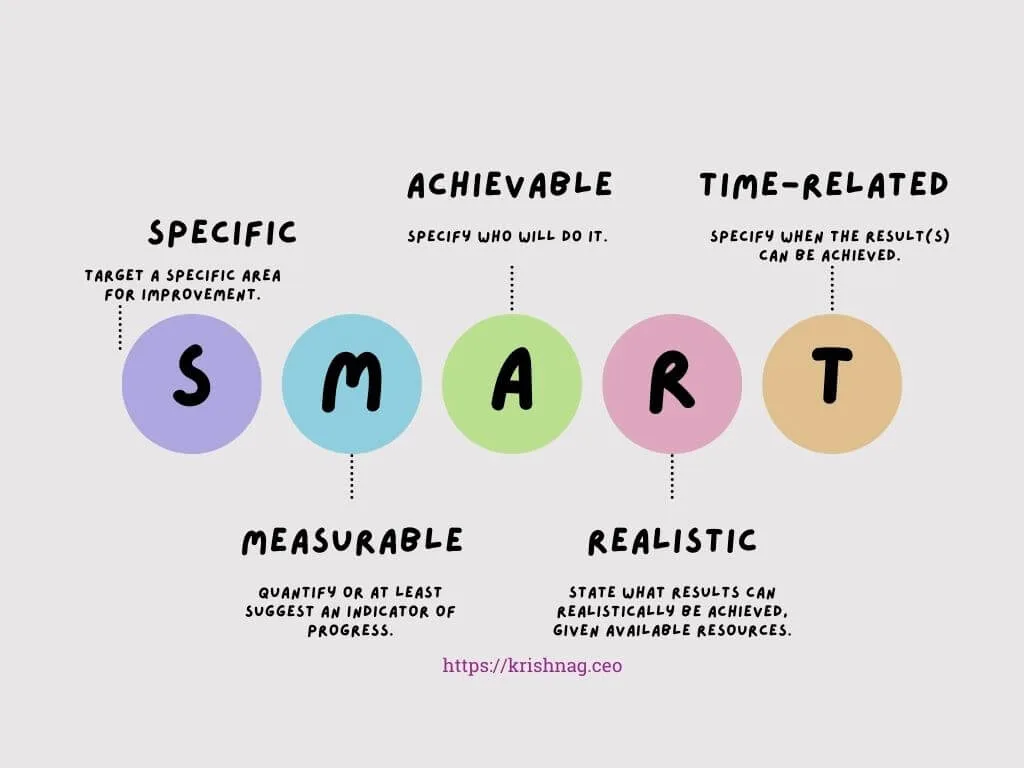SMART Goals
What are SMART Goals?
SMART is a mnemonic acronym that means Specific, Measurable, Achievable, Relevant, and Time-bound. It’s a framework used to set goals that are clear, well-defined, and likely to be achieved.
Here’s an analysis of each SMART goal element:
- Specific: The goal should be specific and clearly defined. What exactly do you want to achieve? Avoid vague or ambiguous statements.
- Measurable: The goal should have metrics to track your progress and direct if you are achieving it. Identify how you will measure success and set quantifiable metrics.
- Achievable: The goal should be achievable but challenging. It should be ambitious enough to motivate you but realistic enough to be attained with effort.
- Relevant: The goal should be relevant to your business objectives and priorities. Ensure it aligns with your bigger picture and contributes to your overall success.
- Time-bound: The goal should have an accurate timeframe for accomplishment. Set a deadline to hold yourself accountable and create a sense of importance.
Benefits of using SMART goals:
- Increased focus and clarity: SMART goals clearly define what you want to achieve and how you will get there.
- Improved motivation and engagement: SMART goals are more likely to motivate you and your team to take action and achieve results.
- Enhanced performance and productivity: Setting SMART goals allows you to focus on the most important tasks and track your progress, leading to better performance and productivity.
- Greater accountability and responsibility: SMART goals provide a framework for holding yourself and your team accountable for achieving the desired outcomes.
Examples of SMART goals:
- Increase website traffic by 20% within the next three months. (Specific, Measurable, Achievable, Relevant, Time-bound)
- Complete the online marketing certification course within the next six months. (Specific, Measurable, Achievable, Relevant, Time-bound)
- Improve customer satisfaction rating by 5% by the end of the year. (Specific, Measurable, Achievable, Relevant, Time-bound)
Using the SMART framework, you can set goals that are more likely to be achieved and contribute to your overall success.

What are the drawbacks of SMART Goals?
Despite being a popular and effective goal-setting framework, SMART goals also have drawbacks. Here are a few:
Rigidity and lack of adaptability: SMART goals require clear and specific details, which can help you stay on track. However, this can also lead to inflexibility and make it difficult to adapt to changing situations. Unforeseen obstacles or opportunities might arise that require adjustments to your goals, but the rigidity of SMART goals can make it challenging to do so.
Oversimplification and lack of nuance: By focusing solely on specific, measurable, achievable, relevant, and time-bound aspects, SMART goals can sometimes oversimplify complex goals and miss important nuances. They may not fully capture your goals’ emotional significance, intrinsic motivation, or broader context. This can lead to a feeling that your goals are not fully aligned with your values and aspirations.
Neglecting other essential areas: Focusing solely on achieving SMART goals can lead to ignoring other vital areas of your life. Pursuing one specific goal might require sacrificing time and attention that would otherwise be devoted to different personal or professional aspirations. This can create a sense of imbalance and hinder overall well-being.
Lack of motivation and focus: While SMART goals can provide direction and clarity, they may not be inherently motivating for everyone. These goals’ specific and measurable nature can sometimes feel overwhelming or tedious, leading to a lack of excitement and enthusiasm. Staying focused and committed to achieving your goals can make it challenging.
Overemphasis on outcomes over process: SMART goals are outcome-oriented, meaning they focus on the final achievement rather than the journey itself. This can lead to unhealthy ways of achieving results at any cost, neglecting the importance of enjoying the process and learning. It can also create unnecessary pressure and anxiety about achieving specific outcomes.
Here are some additional drawbacks of SMART goals:
- Limited creativity and innovation: The rigid structure of SMART goals can stifle creativity and make exploring new ideas or approaches challenging.
- Potential for discouragement: Falling behind on your SMART goals can be dis-motivating and lead to losing motivation.
- Time-consuming to create and maintain: Creating and tracking SMART goals can be time-consuming and require significant effort.
It’s important to remember that SMART goals are just a framework and should not be used as a rigid formula. The best approach is to be flexible and adapt your goals to fit your individual needs and circumstances. You might also consider using other goal-setting frameworks that complement SMART goals, such as OKRs (Objectives and Key Results) or BHAGs (Big Hairy Audacious Goals).
Ultimately, the most effective goal-setting approach is the one that works best for you. Be open to experimenting and finding what helps you stay focused and on the way to accomplishing your goals.
-
Product on sale
%22%20transform%3D%22translate(.6%20.6)%20scale(1.17188)%22%20fill-opacity%3D%22.5%22%3E%3Cellipse%20fill%3D%22%236658b3%22%20rx%3D%221%22%20ry%3D%221%22%20transform%3D%22matrix(-5.46863%2055.28304%20-88.12238%20-8.71712%20171.3%20114.4)%22%2F%3E%3Cellipse%20fill%3D%22%23fff%22%20cy%3D%22255%22%20rx%3D%22140%22%20ry%3D%22140%22%2F%3E%3Cellipse%20fill%3D%22%23fff%22%20rx%3D%221%22%20ry%3D%221%22%20transform%3D%22rotate(-161.9%2010.5%2066)%20scale(62.67315%20254.99999)%22%2F%3E%3Cellipse%20fill%3D%22%23fff%22%20cx%3D%22207%22%20cy%3D%22255%22%20rx%3D%2279%22%20ry%3D%2279%22%2F%3E%3C%2Fg%3E%3C%2Fsvg%3E) Secure CEO-as-a-ServiceOriginal price was: €288.00.€228.00Current price is: €228.00.
Secure CEO-as-a-ServiceOriginal price was: €288.00.€228.00Current price is: €228.00.

